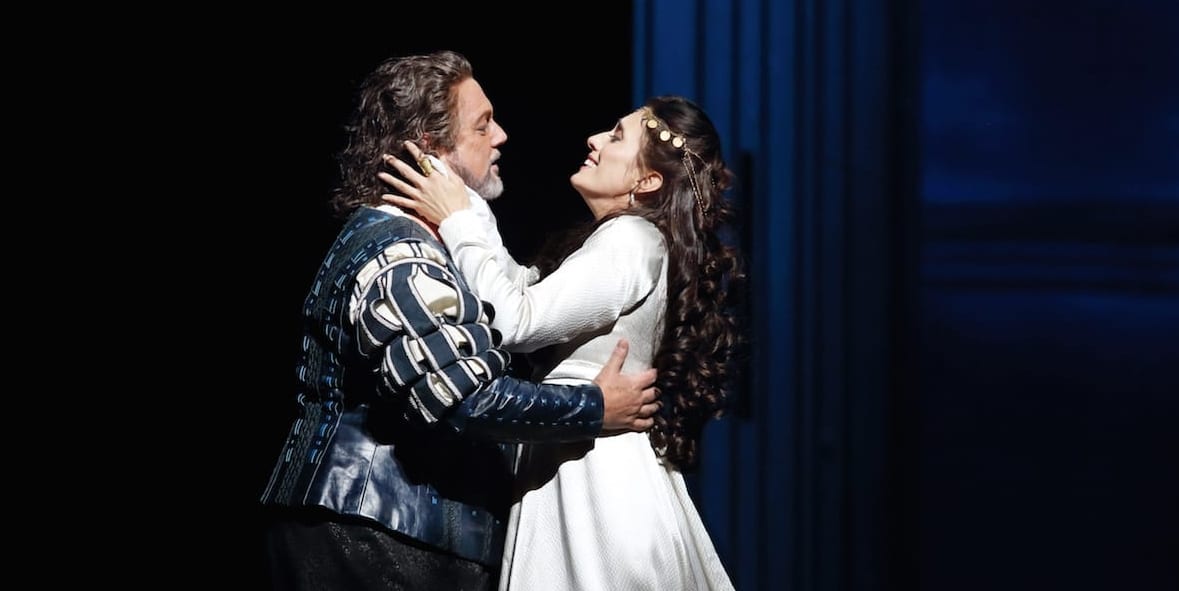When Bernard Shaw wrote that ‘Othello’ was ‘a play written by Shakespeare in the style of Italian opera’, he was onto something more than just a witty paradox. Though many years went into the composition of Verdi’s consummate distillation of his career-long operatic experience, the subject matter and story could not be better suited to the genre – a tragic love story, grand moments of political spectacle that mesh with the private drama, a villain on an epic scale, and the most spectacular of heroic falls from grace and prosperity down
into moral degradation and murder. Moreover, the questions of race and gender that seethe
under the surface can be channelled by the right director into apt contemporary commentary. Above all, it is a huge arc of an emotional journey encompassing the most exquisite of love duets and the most nihilistic and chilling negations of human connection.
Against this demanding standard, this first revival of Keith Warner’s 2017 production produces mixed emotions. Musically, whether on stage or in the pit, the results are first-rate; but there were plenty of times when I closed my eyes to the visual aspects because they either cut across or crudely and unnecessarily underlined points already made perfectly well in the score and text.
In the title role, Gregory Kunde emerges from the shadow of Jonas Kauffman last time around to acquit himself with real credit. The voice is still more than equal to this very demanding role, and he traverses the emotional expanses of the part with dexterity and stamina. He is well-matched with Ermonela Jaho, who to her credit puts up a real fight as Desdemona, showing herself to be nobody’s pearl-clutching easy victim. She is at her best in the Willow Song and Ave Maria of the final act where her fine-spun tone draws the listener into her predicament with grace and fine-spun vocal refinement. But in some ways, the greatest responsibility in this opera rests with the singer representing Iago (after whom the
opera was originally titled). Carlos Álvarez captures the cunning, blank negativity and menace of the role admirably – both the bluff soldier and the inventive intriguer – and his ‘Credo’ is sung with bold, jaw-jutting, conviction and swagger.
There are no weak links in the supporting cast and chorus: even minor roles are sung with presence and power. The gaggle of children are admirably sweet-toned and tuned, and the main chorus really do act out individual roles as well as coming together for the show-piece
sections, such as the opening storm and the arrival of the Venetian ambassadors in Cyprus. Pappano sets a brisk pace in the pit but finds the give and take, ebb and flow, that this opera needs to allow for its full emotional force to be felt. There was enough relaxation to
allow orchestral solos to be relished and for the voices to get both the bedrock support and spot-lit focus when they needed it.T
hat leaves the production….
The costumes are broadly in period and offer colour and contrast as needed. The sound scheme is well integrated with the orchestra – thunder and lightning are there but not unbalanced. The lighting is gloomy for the most part so that it is not always easy to see key moments in detail even when sitting quite close to the stage. The set is the main problem. This largely consists of a series of black metal sheets and screens that slide across the stage and retreat or encroach to narrow or broaden the action. The bleak, stark setting is broken into at points by incongruous colourful intrusions almost in a fit of guilt at having deprived us of colour. The most bizarre of these comes at the arrival of the ambassadors when a plaster lion of Venice slides gratuitously across the stage like an oversized cuddly toy on a gameshow conveyor-belt. It then reappears broken in pieces in Othello’s quarters in Act IV (which at least is decked out in pure white). Do we really need these heavy-handed reminders when the final devastating tableau of Act 3 already has Iago standing over the prone Othello – ‘Behold the Lion of Venice’?
Has no one learned that less is often more?

